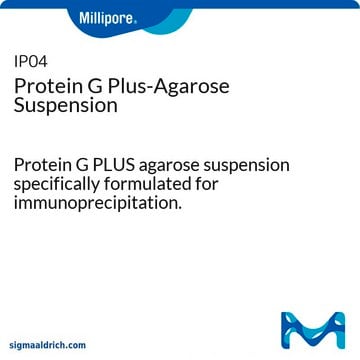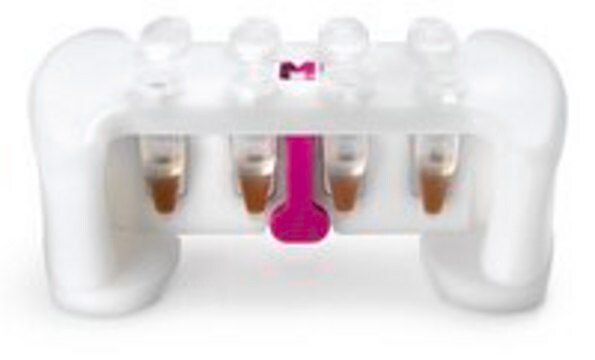IP10
Protein G Plus/Protein A-Agarose
A mixture of Protein G PLUS and Protein A covalently conjugated to agarose. Useful for purification of IgG from biological fluids.
Synonim(y):
Protein G/Agarose
About This Item
Polecane produkty
Postać
slurry (Liquid)
zawiera
≤0.1% sodium azide as preservative
producent / nazwa handlowa
Calbiochem®
warunki przechowywania
do not freeze
metody
protein purification: suitable
przydatność
suitable for microbiology
Warunki transportu
wet ice
temp. przechowywania
2-8°C
Powiązane kategorie
Opis ogólny
Zastosowanie
Ostrzeżenie
Postać fizyczna
Inne uwagi
Recommended Protocol for IgG Purification
Buffers
All concentrations stated are for working solutions, not the 10X concentrates. Caution: sodium azide is poison.
• Binding/Washing Buffer: 100 mM sodium phosphate pH 7.0, 150 mM sodium chloride, 5 mM sodium EDTA, 0.01% sodium azide.
• Elution Buffer A (see Note section): 500 mM ammonium acetate pH 3.0, 0.01% sodium azide.
• Elution Buffer B: 10 mM glycine/HCl pH 3.0, and 0.01% sodium azide.
• Neutralization Buffer: 500 mM Tris Base, 0.01% sodium azide.
• Storage Buffer: 100 mM sodium phosphate, pH 7.0, 0.01% sodium azide.
Protocol
A. Clean Up and Concentration
Ascites and serum should be clotted at room temperature, refrigerated at 4°C overnight (to allow the clot to shrink and lipids to separate), and centrifuged multiple times to remove all clotted protein and lipid. Remove the lipid from the top of the centrifuge tube with a glass rod or small wooden stick. Tissue culture media should be centrifuged or filtered to remove aggregates.
IgG can be concentrated and partially purified by use of an ammonium sulfate precipitation step. Add ammonium sulfate to 50% saturation (313 g per L) with stirring and check the pH adjusting to 7.0 by addition of 1 M HCl or NaOH. Centrifuge to collect precipitated immunoglobulin, dissolve in binding buffer and dialyze against the same buffer.
B. Purification
1. Pack a column with the Agarose Conjugate.
2. Wash with about 20 column volumes Washing/Binding Buffer until pH of eluate is 7.0.
3. If IgG has not been previously dialyzed against binding buffers dilute or dialyze IgG-containing sample into the Washing/Binding Buffer (pH 6.5-7.5).
4. Load sample onto column.
5. Wash with Washing/Binding Buffer until the absorbance of the eluate at 280 nm approaches background level.
6. Wash with Elution Buffer A to elute IgG, and collect fractions until A280 returns to background levels.
7. Wash with Elution Buffer B, and collect fractions until A280 returns to background. Most IgG should elute with buffer A.
8. Neutralize eluted IgG fractions by addition of an equal volume of neutralization buffer and check the pH with pH paper. For best results, neutralize eluate promptly.
9. To re-use the column immediately, repeat procedure from Step 2.
10. To prepare the column for storage, wash column with 5 column volumes of Elution Buffer B.
11. To store column wash with 30 column volumes storage buffer; then seal column outlets and store in refrigerator.
12. Quantitate the purified IgG using the formula:
Absorbance at 280 nm/1.4 = Concentration (mg/ml).
To make Elution Buffer A, start with acetic acid and adjust the pH to 3.0 with ammonium hydroxide.
Informacje prawne
Kod klasy składowania
11 - Combustible Solids
Klasa zagrożenia wodnego (WGK)
WGK 1
Temperatura zapłonu (°F)
Not applicable
Temperatura zapłonu (°C)
Not applicable
Certyfikaty analizy (CoA)
Poszukaj Certyfikaty analizy (CoA), wpisując numer partii/serii produktów. Numery serii i partii można znaleźć na etykiecie produktu po słowach „seria” lub „partia”.
Masz już ten produkt?
Dokumenty związane z niedawno zakupionymi produktami zostały zamieszczone w Bibliotece dokumentów.
Powiązane treści
We manufacture IP and antibody purification agarose beads that purify immunoglobulins and IgG fractions. Our kits also provide a total antibody purification process
Nasz zespół naukowców ma doświadczenie we wszystkich obszarach badań, w tym w naukach przyrodniczych, materiałoznawstwie, syntezie chemicznej, chromatografii, analityce i wielu innych dziedzinach.
Skontaktuj się z zespołem ds. pomocy technicznej








